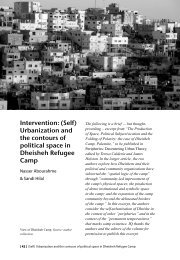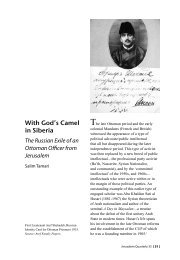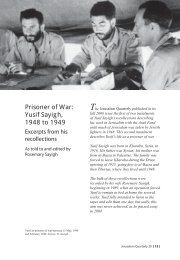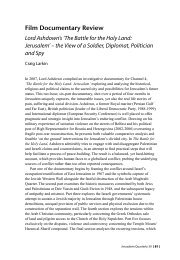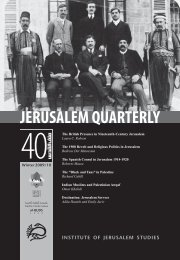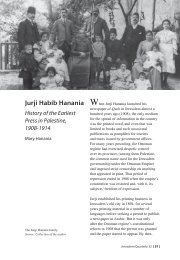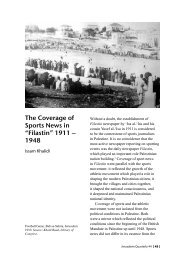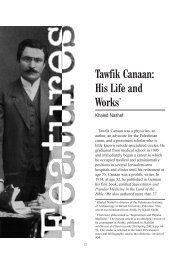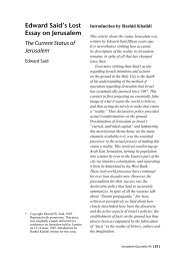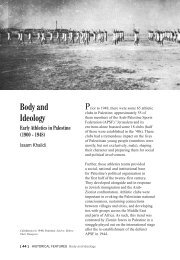Assassination in Jerusalem - Jerusalem Quarterly
Assassination in Jerusalem - Jerusalem Quarterly
Assassination in Jerusalem - Jerusalem Quarterly
Create successful ePaper yourself
Turn your PDF publications into a flip-book with our unique Google optimized e-Paper software.
the time for noon prayers drew closer. The streets were heavy with anger. As men<br />
and women entered the gates of the al Aqsa Mosque their faces betrayed worry and<br />
sadness.” 1<br />
Sigrist was driv<strong>in</strong>g a left-hand drive car on the right side of the road as cars had<br />
been <strong>in</strong>troduced to Palest<strong>in</strong>e <strong>in</strong> the Ottoman era, before the British – who drive on the<br />
left – arrived <strong>in</strong> 1917. 2 Doxat sat to Sigrist’s right <strong>in</strong> the passenger seat armed with a<br />
British Army-issue Lee-Enfield rifle as well as a Service revolver pistol. As the two<br />
men drove away from St. Stephen’s Gate follow<strong>in</strong>g Sigrist’s visit to the police picket<br />
there, the assass<strong>in</strong>s, who had been track<strong>in</strong>g Sigrist’s daily schedule, struck on the<br />
Jericho road just outside, shoot<strong>in</strong>g Sigrist as he was return<strong>in</strong>g to Herod’s Gate on the<br />
<strong>in</strong>cl<strong>in</strong>e by the Muslim cemetery a few meters before the turn at the northeast corner<br />
of the Old City walls. Sigrist be<strong>in</strong>g on the road-side of the car meant that the two<br />
assass<strong>in</strong>s had to step <strong>in</strong>to the middle of the road to shoot him, and as both men aimed<br />
at Sigrist this left Doxat temporarily free to return fire. The assass<strong>in</strong>s had chosen<br />
this spot as Sigrist’s car slowed on the <strong>in</strong>cl<strong>in</strong>e before the turn<strong>in</strong>g; Abu Gharbiyah’s<br />
memory is that both men were “calm and <strong>in</strong> full control of the situation” when they<br />
launched their attack. 3<br />
In June 2009, Abu Gharbiyah, now n<strong>in</strong>ety-three, consented to an <strong>in</strong>terview with<br />
this author at his home <strong>in</strong> Amman, Jordan. 4 His recollections supplemented by<br />
contemporary records provide a useful counter-narrative to the traditional British<br />
account of undiluted rebel terrorism, and one that this essay will go on to describe <strong>in</strong><br />
an attempt to explore the contested terra<strong>in</strong> of who used violence <strong>in</strong> Palest<strong>in</strong>e at this<br />
time and for what purpose. Us<strong>in</strong>g the shoot<strong>in</strong>g of Sigrist as a case study opens up<br />
wider debates on official and unofficial aggression, complement<strong>in</strong>g recent academic<br />
studies on Brita<strong>in</strong>’s use of force <strong>in</strong> Palest<strong>in</strong>e at this time, and giv<strong>in</strong>g voice to what<br />
Edward Said has described as the “<strong>in</strong>visible and <strong>in</strong>audible” Palest<strong>in</strong>ians who fought<br />
the British <strong>in</strong> the late 1930s. 5 That said, oral history and memory have their pitfalls.<br />
Thus, a British Palest<strong>in</strong>e police contemporary of Sigrist (and present at his funeral<br />
some twenty years ago) read this author’s account of Sigrist’s activities <strong>in</strong> <strong>Jerusalem</strong><br />
and remembered Sigrist as a “pleasant chap and a bit of a scholar,” a description that<br />
jars with the account that follows of Sigrist’s violence directed at Palest<strong>in</strong>ians, as<br />
readers will discover. 6<br />
The shoot<strong>in</strong>g of Sigrist gets little mention <strong>in</strong> the literature, not surpris<strong>in</strong>g<br />
consider<strong>in</strong>g the large number of attacks on British officials dur<strong>in</strong>g the revolt <strong>in</strong><br />
Palest<strong>in</strong>e. In Tom Segev’s One Palest<strong>in</strong>e, Complete (2000), the outrage is recorded<br />
simply as, “a young Arab [al-Ansari] opened fire on the car of a <strong>Jerusalem</strong> police<br />
officer, wound<strong>in</strong>g him. A British soldier returned fire; the Arab was hit and later<br />
died.” 7 The Palest<strong>in</strong>e Post reported that the two assass<strong>in</strong>s had hidden below the side of<br />
the Jericho road before the attack, a claim refuted by Abu Gharbiyah who later wrote<br />
that they were both walk<strong>in</strong>g openly <strong>in</strong> the street; other accounts have the men jump<strong>in</strong>g<br />
on and, <strong>in</strong> one case, <strong>in</strong>to the car. 8 Abu Gharbiyah hid his weapon under his tarbush<br />
while al-Ansari’s was <strong>in</strong> his pocket – both men had automatic pistols, Abu Gharbiyah<br />
an Italian Beretta and al-Ansari a French Lafayette. 9 Abu Gharbiyah and al-Ansari<br />
[ 6 ] <strong>Assass<strong>in</strong>ation</strong> <strong>in</strong> <strong>Jerusalem</strong>


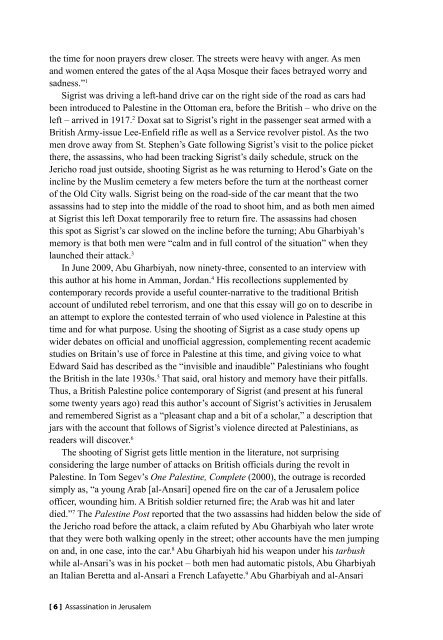
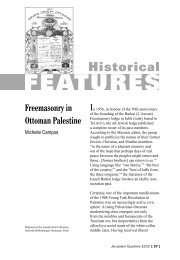
![In Search of Jerusalem Airport [pdf] - Jerusalem Quarterly](https://img.yumpu.com/49007736/1/180x260/in-search-of-jerusalem-airport-pdf-jerusalem-quarterly.jpg?quality=85)
